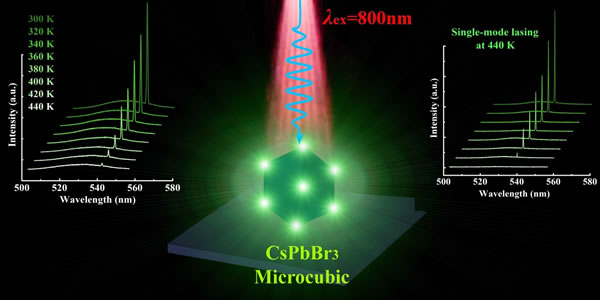Recently, the Shanghai Institute of Optics and Fine Mechanics of the Chinese Academy of Sciences has cooperated with the Nanjing University of Aeronautics and Astronautics and the Institute of Semiconductors of the Chinese Academy of Sciences to successfully prepare high-quality, low-threshold single-crystal all-inorganic perovskite CsPbBr3 microcavities and obtain high-temperature stable up-conversion Single mode lasing. This research provides new ideas for the integration of microcavities on optical sheets, and related research results have been published in the journal ACS Photonics. Narrow linewidth, ultra-high-quality single-mode nano lasers have many potential applications in physics and engineering, such as on-chip optical integration, coherent detection, and quantum information processing. The all-inorganic perovskite CsPbBr3 semiconductor material has received extensive attention and research as a high-gain material. However, poor thermal stability has been the biggest problem limiting this material. At present, most perovskite microcavities can only obtain lasing at room temperature or even low temperature, which greatly limits the application of high-power integrated optoelectronic devices and perovskite electric pump lasers. Therefore, improving the thermal stability of the perovskite microcavity to obtain a stable high-quality single-mode laser output is an urgent problem to be solved. The single-crystal all-inorganic perovskite CsPbBr3 microcavity prepared by the research team raised the working temperature of the perovskite microcavity to 440K for the first time, and at 440K, the single-mode lasing at 540nm can still be obtained. The lasing energy can be maintained at a relative intensity of 1 for 60 minutes under a 1.4-times threshold power pump (7.2 × 104 pump excitation cycle). In addition, at room temperature, single-mode lasing output with a quality factor of up to 1.01 × 104 can also be obtained by two-photon pumping at 800 nm. The research team also used 3D stereoscopic simulation to analyze the complex patterns in the cubic microcavity, and calculated that there are multiple sets of patterns in the cubic microcavity. The results show that as the volume of the microcavity decreases, not only the number of modes decreases, but the number of modes also decreases. Finally, when the size of the cube microcavity is 1.7mm, single-mode laser output can be obtained. Relevant achievements were unanimously approved by peer review. The research was funded by the National Natural Science Foundation of China (61675219, 61875256, 61475173, 11474297, 11674343), the Youth Innovation Promotion Association of the Chinese Academy of Sciences and the Shanghai Science and Technology Commission (No. 17ZR1444000). China Aluminum Curved,Pvc Coated Garden Gate,Public Grounds Fence,Indoor Security Fence, we offered that you can trust. Welcome to do business with us. Aluminum Curved,Pvc Coated Garden Gate,Public Grounds Fence,Indoor Security Fence Anping Xinlong Wire Mesh Manufacture Co.,Ltd. , https://www.xinlongfence.com
Figure: High temperature characteristics of perovskite CsPbBr3 cubic microcavity.